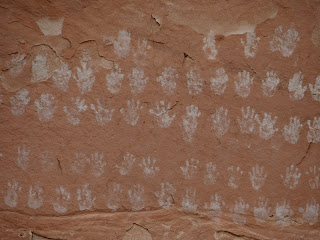Did I say that Bryce is popular? It was late September and it was still hard to find parking spaces and dodge tourist buses--again, mostly European tourists, but some Japanese. But our favorite was a group of African-American church ladies (Upon seeing a photographer at the edge of the rim, one lady exclaimed: "Look at him! Lord, Jesus, no way, no how." Even her companions were amused.) Sure enough, checking out their bus we saw it was a tour out of Baltimore.
Bryce is worth a visit. The orange pinnacles are called "hoodoos" and contrast brilliantly with the green canopy of spruces and firs.
It is a great splash of color, like orange popsicles gone wild.
Cameras were popping everywhere and mine too.
I liked the white caps.
It was a great opportunity to play with telephoto images.
With so many hoodoos, it was hard not to burst into Cole Porter songs or Dr. Seuss versicles.
We headed back to Capital Reef area in the early afternoon.
But before we camped for the night, we stopped at two rock art sights.
The first is called the "Hundred Hands" panel and is located in the Escalante River Canyon.
A beautiful spot. The trailhead starts with some pleasant advisories.
We especially appreciated the warning: "You could die out here."
Gee, thanks for the input. I think it meant getting run over by an RV--which was trying to park in small lot beside the river that I wanted to get into.
What the park did not say is where to find the Hundred Hands panel. We found it; way up there.
Can you see the hundred hands?
Now you can.
And so we climbed up and up. Janet is getting a lot braver about these things.
The name of the panel is a misnomer. I counted four to five rows of at least 40 handprints. None of the prints were in pairs and none were the same.
This was a Fremont village that made a statement. The height of the panel and steepness of the slope made it impossible to get too close, but binoculars and a telephoto lens gave us a good sense of each print.
How they were made is another issue.
In our judgment, the area was fertile (still is) with terraces ideal for farming, which the Fremont did.
Indeed further exploration revealed evidence of granaries (Fremont?) throughout the canyon system.
The location of the panel was also an ideal defensive spot to see movement throughout the nearby canyon system.
(Can you spot our Jeep?)
On the way down, as we carefully maneuvered across some narrow ledge,
we had a surprise. We did not expect to find a little mountain ram serving as our good luck charm.
Or was it telling us something?
Not content to call it a day, we headed a few miles further north to Pleasant Creek canyon. Along the trail we spotted some granaries across the river bed.
They were all quite high up.
But about two miles up we found the pictograph we were looking for. It was about 300 yards away, across the creek and inaccessible.
The Fremont usually did not do pictographs, but this one is a classic.
We expected to see the three warriors, although again it took binoculars to do so. But what a surprise when we looked again at the photo. We did not see the faint Barrier Canyon "rain" figure next to them.
By late afternoon we decided it was time to head north. The closest campground--the closest anything--was Torrey, Utah, 70 miles away. Down the valleys of the Grand Staircase we charged. Cows to the left of us; cows to the right of us; cows ahead of us. Nope, that's a deer, admiring our headlights as we descend a curve. Stop short; catch the flying stove with the right elbow. At least it was not a headlight in the deer. That little ram really was good luck.






















No comments:
Post a Comment